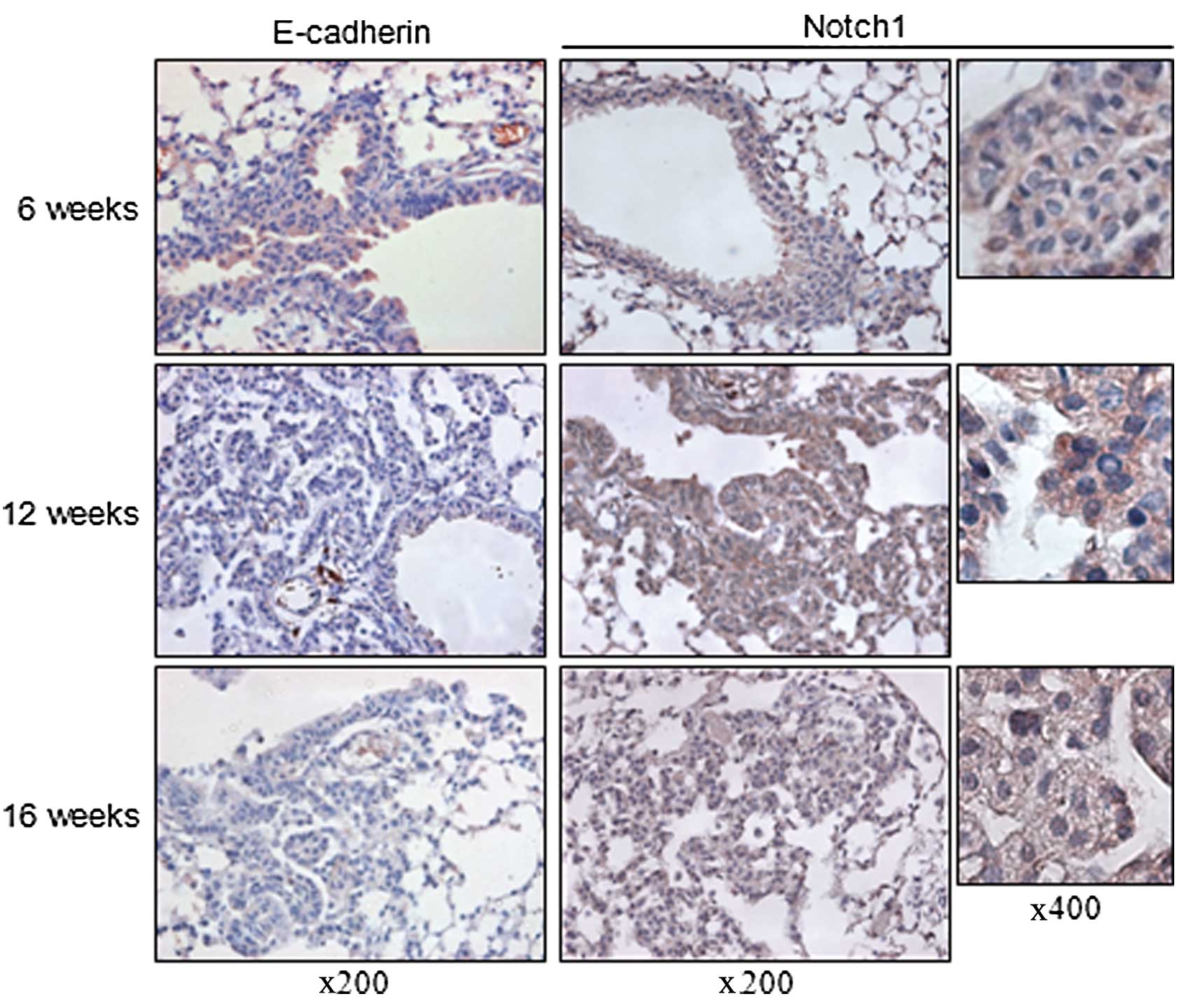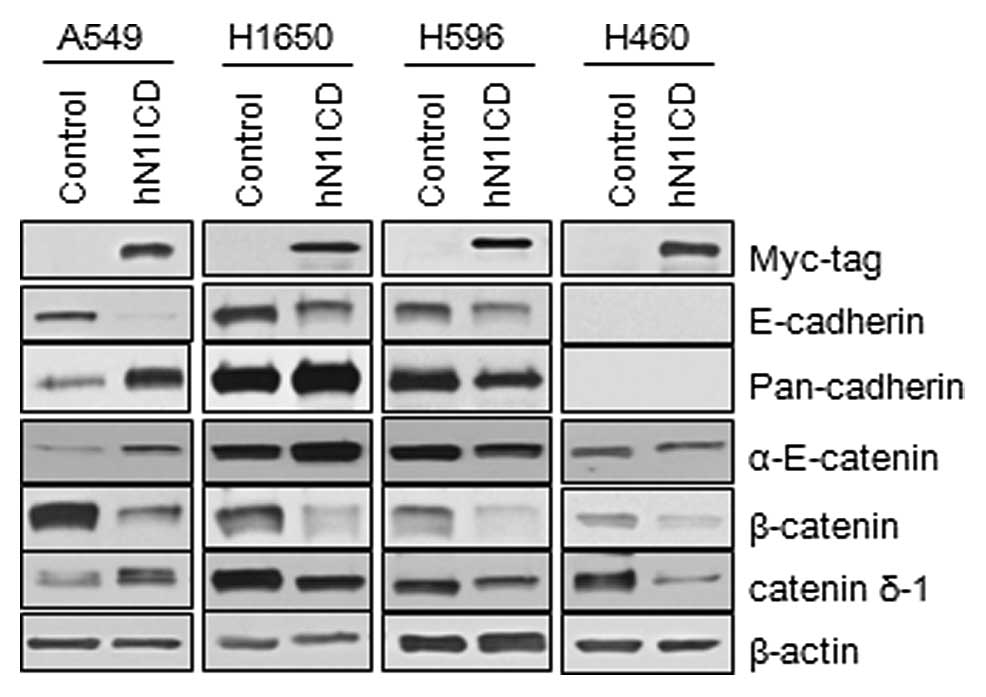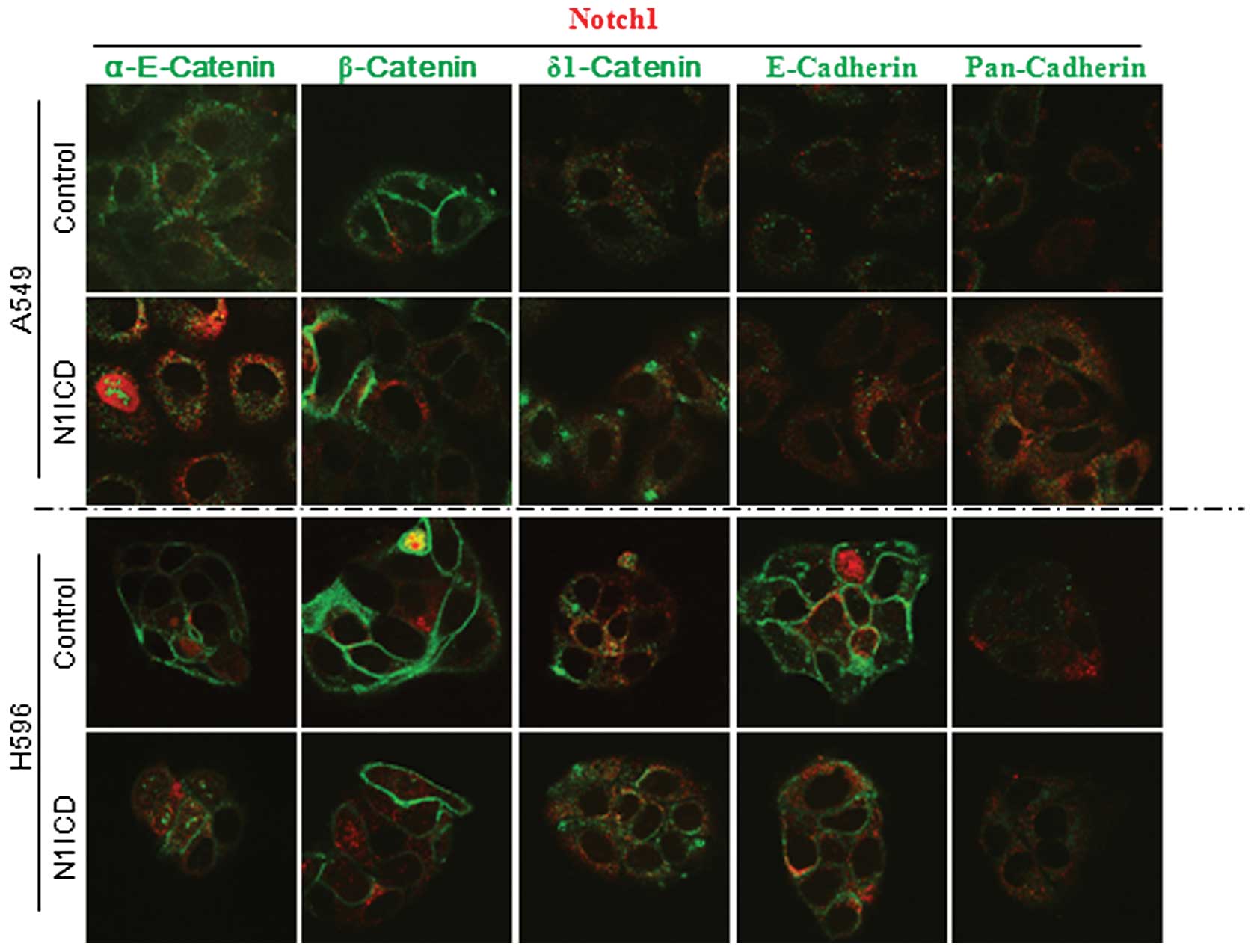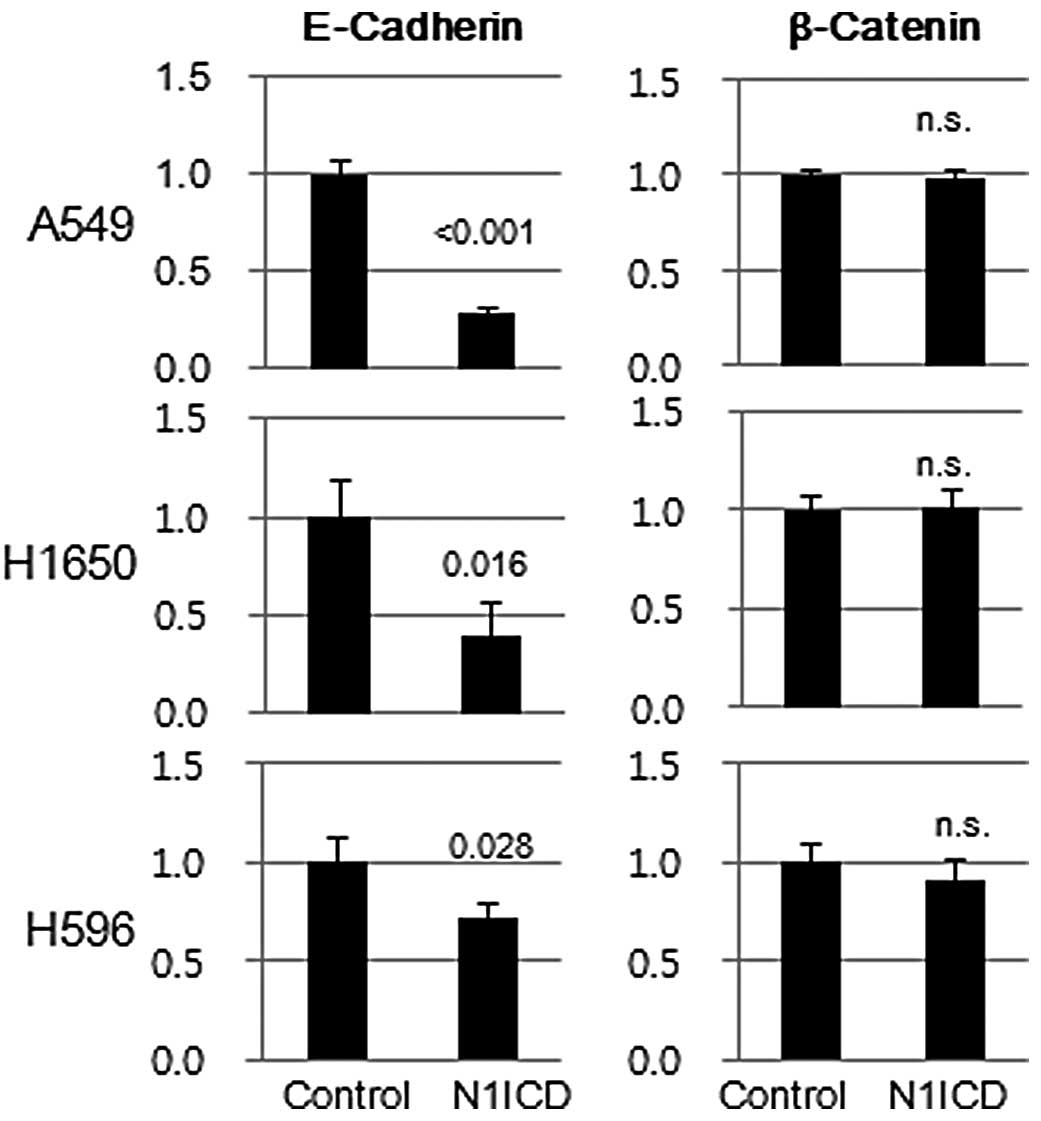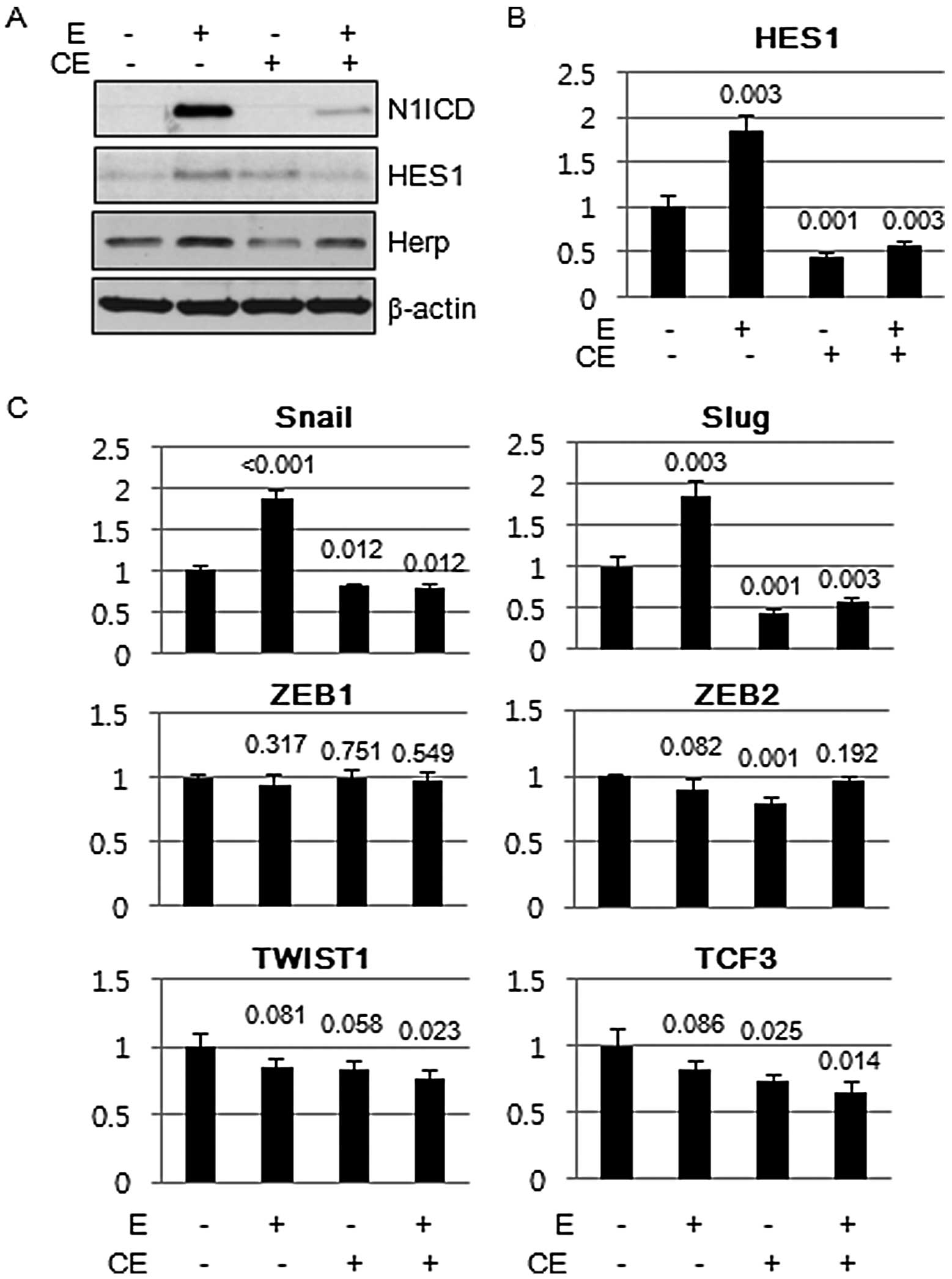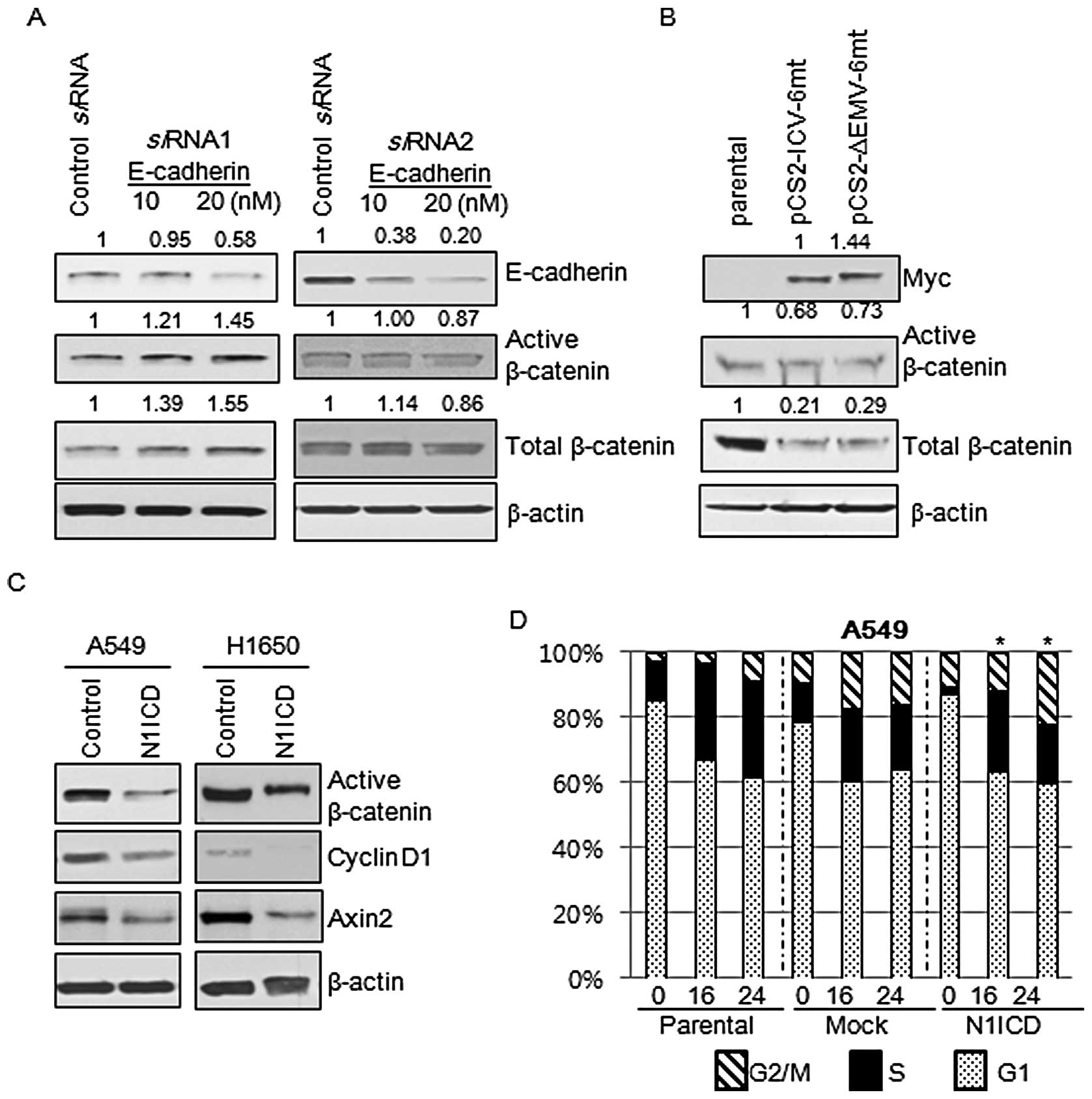Notch1 destabilizes the adherens junction complex through upregulation of the Snail family of E-cadherin repressors in non-small cell lung cancer
- Authors:
- Published online on: June 26, 2013 https://doi.org/10.3892/or.2013.2565
- Pages: 1423-1429
Abstract
Introduction
According to the 2011 annual report on the global burden of cancer, 1,600,000 new cases of lung cancer were noted in 2008, which accounted for 13% of the total cancer cases worldwide, and there were 1,400,000 lung cancer-related deaths during the same period, which accounted for 18% of all cancer-related mortality making lung cancer the leading cause of cancer-related death worldwide (1). Lung cancer has a very poor prognosis compared with other cancer types, indicating that there is an urgent need for new therapies for non-small cell lung cancer (NSCLC) by elucidating the mechanisms of its growth and progression.
The single-pass heterodimeric transmembrane receptor protein, Notch1, localizes on the cell surface and mediates cell-to-cell interactions. When the extracellular domain of Notch1 dissociates from the heterodimerization domain through interaction with ligand cells, the Notch1 receptor undergoes sequential proteolytic cleavage and the Notch1 intracellular domain (N1ICD) is released and translocates to the nucleus where it activates transcription of target genes (2). During the neoplastic process, the tumor microenvironment becomes more solid and hypoxic resulting in intensified interactions between cells, which eventually generate conditions with amplified Notch1 signaling (3,4).
Although the oncogenic role of Notch1 has been established in T-acute lymphoblastic leukemia, its roles in other neoplastic diseases are controversial (5). In T-cells, N1ICD induces the expression of cyclin D3, CDK4 and CDK6, leading to G1-S cell cycle phase progression (6). Other authors have reported that Notch1 signaling inhibits B lymphocyte growth (7), small cell lung cancer (8) and hepatocellular carcinoma (9). Since deregulated Notch1 signaling is common in NSCLC (10,11) and several γ-secretase inhibitors (GSIs) are under development for various clinical applications, clarification of its role is required.
Among the intercellular junctional complexes which maintain epithelial integrity and polarity, adherens junctions are made up of homophillic interactions between E-cadherin molecules and α-catenin, β-catenin and δ1-catenin (p-120), which are connected to the actin cytoskeletal network. Interaction between E-cadherin and β-catenin stabilizes cell-to-cell contacts and maintains adherens junctions, and is important for cell-to-cell interaction-mediated signaling (12). Destabilization of adherens junctions facilitates endocytosis of E-cadherin and changes in the levels of β-catenin in various cellular compartments. Disruption of E-cadherin/β-catenin complexes also decreases intercellular adhesion and further increases cell migration and invasiveness (13,14). Physical interaction of Notch1 with β-catenin through the RAM domain of Notch1 suggests another role of Notch1 in maintaining the stability of adherens junctions (15). By elucidating the function of Notch1 in adherens junctions, the context-dependent role of Notch1 may become clear.
In the present study, we investigated the role of Notch1 in adherens junction stability and NSCLC cell growth. Overexpression of N1ICD decreased E-cadherin through upregulation of the snail family of transcription repressors and it resulted in the alteration of total and active β-catenin expression. We found that Notch1 and β-catenin interact independently to E-cadherin expression and that Notch1 deregulates Wnt/β-catenin signaling. Our results suggest that Notch1 is an important component involved in the physical and signaling homeostasis of adherens junctions.
Materials and methods
Plasmids, antibodies and cell cycle analysis
A549 cells were purchased from ATCC (Manassas, VA, USA). H460, H596 and H1650 cells were obtained from the Korean Cell Line Bank (Seoul, Korea). pMSCV-myc-N1ICD and -control vectors were obtained from Dr G. Jung (Seoul National University) and transduced as previously described (5). pCS2-ICV-6mt and pCS2-ΔEMV-6mt were gifts from Dr R. Kopan (http://devbio.wustl.edu/kopannulab/plasmids.htm) (16). Anti-Notch1 (C-20)-R and (C-10), -HES1, -HERP, -c-Myc were purchased from Santa Cruz Biotechnology, Inc. (Santa Cruz, CA, USA), and antibodies, unless otherwise stated, were obtained from Cell Signaling Technology (Danvers, MA, USA). For cell cycle analysis, cells were serum starved for 36 h and then released from cell cycle arrest by replacing the RPMI media supplemented with 10% FBS. Cells were stained with propidium iodide and analyzed using a FACSCanto II flow cytometer (Becton-Dickinson, Franklin Lakes, NJ, USA).
Animal model and immunohistochemistry (IHC)
Lox-Stop-Lox (LSL) K-ras G12D mice were obtained from the NCI mouse repository (http://mouse.ncifcrf.gov/), bred, and genotyped according to the supplier's guidelines. This animal study was approved by our Institutional Animal Care and Use Committee, following the guidelines of the American Association for the Assessment and Accreditation of Laboratory Animal Care. AdCre virus was obtained from the Gene Transfer Vector Core of the University of Iowa (Iowa City, IA, USA). Eight-week-old heterozygotes were intranasally infected with 5×108 PFU of the AdCre virus according to a protocol described elsewhere (17). Six, 12 and 16 weeks after infection, mice were sacrificed, and expression of E-cadherin and Notch1 were analyzed using IHC. IHC was performed using the LABS®2 System (Dako, Carpinteria, CA, USA) according to the manufacturer's instructions. Briefly, sections were deparaffinization, rehydrated, immersed in H2O2-methanol solution, and then incubated overnight with primary anti-E-cadherin or -Notch1 antibodies in antibody diluent (Dako) at a 1:100 dilution. Sections were incubated for 10 min with biotinylated linker and processed using avidin-biotin IHC techniques. 3,3′-Diaminobenzidine (DAB) was used as a chromogen in conjunction with the Liquid DAB Substrate kit (Novacastra, UK).
Quantitative real time (RT)-PCR
Total RNA was extracted using TRI reagent® (Ambion, Austin, TX, USA). Quantitative RT-PCR analysis was conducted using TaqMan® Gene Expression assay reagents and the StepOnePlus™ Real-Time PCR system (Applied Biosystems, Carlsbad, CA, USA) using an inventoried primer-probe set described in the company's websites (http://bioinfo.appliedbiosystems.com/genome-database/gene-expression.html).
EDTA treatment and siRNA experiment
Induction of N1ICD and activation of Notch signaling using calcium treatment was described elsewhere (10,18). Briefly, cells were washed two times with Ca2+- and Mg2+-free DPBS and then incubated with DPBS containing 2.5 mM EDTA for 5 min. The media were then replaced with full growth media, and cells were incubated for the indicated times. MISSON® Predesigned siRNA against E-cadherin was obtained from Sigma-Aldrich (St. Louis, MO, USA) and transfected using Lipofectamine® RNAiMAX (Invitrogen, Carlsbad, CA, USA) reagents as per the manufacturer's recommendations.
Western blotting
Cells were harvested using 2X LSB lysis buffer containing protease inhibitor cocktail and phosphatase inhibitor cocktail (Sigma-Aldrich) on ice. After sonication, the BCA protein assay reagent (Thermo Scientific, Rockford, IL, USA) was used for protein quantification. Protein lysates (30–50 mg) were separated by gel electrophoresis on 7.5 to 12% polyacrylamide gels and analyzed by western blot analysis using nitrocellulose membranes (Bio-Rad Laboratories, Inc., Richmond, CA, USA). The expression level of each protein was measured using ImageJ (http://rsbweb.nih.gov/ij/) and quantified relative to that of β-actin.
Immunocytochemistry
Cells (5×105) were plated in 6-well plates containing a sterilized coverslip. On the following day, cells were fixed with 4% formaldehyde in PBS, incubated in blocking solution containing 5% BSA in PBS, and then anti-c-Myc mouse (1:100) and α-E-catenin, β-catenin, δ1-catenin rabbit antibodies (1:200) were added for 16 h. On the following day, the cells were washed, and anti-mouse IgG (Alexa Fluor 555 conjugate) and anti-rabbit IgG (Alexa Flour 488 conjugate) secondary antibodies were added. The nuclei were counterstained with DAPI (1:1,000) in PBS and imaged using an LMS 510 confocal microscope (Carl Zeiss, Oberkochen, Germany).
Statistical analysis
The independent sample t-test was used for univariate analysis of continuous variables. All statistical analyses were two-tailed.
Results
Inverse relationship between E-cadherin and Notch1 expression in a lung cancer mouse model
E-cadherin is an active suppressor of tumor growth and loss of its expression is related to the invasion, metastasis and poor prognosis of cancer whereas the activity of Notch1 signaling correlates with increased intercellular interaction and a hypoxic condition which are related to tumor progression (4,19–21). Therefore, we postulated that there is an inverse relationship between E-cadherin and Notch1 expression. To investigate this, 8-week-old LSL K-ras G12D mice were administered the AdCre virus intranasally and sacrificed at 6, 12 and 16 weeks after viral inhalation. E-cadherin expression decreased with the progression of tumors over time. Compared to the hyperplastic lesions of the mice sacrificed at 6 weeks after AdCre virus inhalation, lesions of the mice sacrificed at 12 and 16 weeks after inhalation showed loss of E-cadherin expression. Notch1 was ubiquitously expressed in the membranous lesions of the normal-appearing bronchial epithelial cells and hyperplastic lesions of the lungs of mice sacrificed at 6 weeks after AdCre virus inhalation. In the neoplastic lesions from the mice which were sacrificed at 12 weeks after virus inhalation, there was increased cytoplasmic expression of Notch1. More frequent nuclear expression of Notch1, which is considered as biologically active, was detected in the neoplastic lesions of the lungs from the mice sacrificed at 16 weeks after inhalation. These findings suggest an inverse relationship between E-cadherin and Notch1 expression with the progression of tumors of LSL K-ras G12D mice (Fig. 1).
Transduction of N1ICD induces changes in the components of adherens junctions
To evaluate the role of Notch1 signaling on adherens junctions, we first transduced either the human N1ICD-myc or the control vector into NSCLC cells and assessed the expression of components of adherens junctions by immunoblotting. The characteristics of the MSCV-N1ICD-myc and MSCV-control vectors are described in Lim et al(5). Transduction of N1ICD was confirmed by expression of the myc tag at the N-terminal of the insert and the overexpression of HES1 and Herp (data not shown). A549, H1650 and H596 cells, which express E-cadherin, and H460 cells, which do not express E-cadherin, showed inhibition of E-cadherin and β-catenin expression. Other components of the adherens junction, α-E-catenin and δ1-catenin, showed different changes depending on the cell lines (Fig. 2). To further evaluate the effect of Notch signaling on adherens junctions, we performed an immunocytochemical study using N1ICD- and control vector-transduced cells. Transduction of N1ICD showed decreased membranous localization of α-E-catenin, β-catenin and E-cadherin in A549, H596 (Fig. 3) and H1650 NSCLC cells (data not shown). Transduction of N1ICD inhibited both protein and mRNA expression of E-cadherin in A5459, H1650 and H596 cells. However, there was no difference in β-catenin mRNA expression between N1ICD- and control vector-transduced cells, which suggests post-translational regulation of β-catenin expression (Fig. 4).
Notch1 inhibits E-cadherin expression through Snail family of transcriptional complex
Calcium chelating agents interfere with the non-covalent binding of the Notch1 ectodermal domain to the Notch1 transmembrane intracellular (NTMIC) domain and facilitate S2 and S3 cleavage of Notch1 to activate Notch signaling (10). Brief exposure to the millimolar concentrations of EDTA resulted in the robust induction of N1ICD in a short period of time, and the signal was propagated to Notch target molecules, namely HES1 and Herp. Pretreatment of cells with compound E, a γ-secretase inhibitor, inhibited the induction of N1ICD and its target molecules (Fig. 5A). HES1 expression was upregulated at the transcriptional level (Fig. 5B). Since induction of E-cadherin repressor complexes is one of the important mechanisms that induces E-cadherin loss, we evaluated the mRNA expression of molecules that comprise the E-cadherin repressor complex by RT-PCR. Among the E-cadherin repressor complex molecules, both Snail and Slug were the E-cadherin repressor complex that showed consistent increase in response to N1ICD induction (Fig. 5C).
N1ICD-induced inhibition of β-catenin is E-cadherin independent
Since the transduction of N1ICD into H460 cells, which do not express E-cadherin, showed a decrease in β-catenin expression, we aimed to ascertain whether the Notch1-mediated inhibition of β-catenin expression was E-cadherin dependent. We treated A549 cells with siRNA against E-cadherin and then evaluated the expression of total and active β-catenin. Active β-catenin, which is not phosphorylated at Ser33/37 and Thr41, is functionally active in cell-to-cell adhesion and the canonical Wnt signaling pathway. A 48-h siRNA treatment revealed that a decrease in E-cadherin expression did not result in decreases in expression of total and active β-catenin (Fig. 6A). These findings suggest that Notch1 inhibits the expression of active and total β-catenin in an E-cadherin-independent manner. Then we questioned whether inhibition of expression of total and active β-catenin was a consequence of the activation of Notch signaling. The membrane-tethered Notch is transcriptionally inactive and considered biologically inert. To be biologically active, Notch1 requires intramembranous cleavage between amino acid Gly1743 and Val1744 mediated by the γ-secretase complex. We transfected A549 cells with biologically active Notch (pCS2-IVC-6mt) and membrane tethered Notch (pCS2-ΔEMV-6mt) and then evaluated the expression of total and active β-catenin. Expression of total and active β-catenin was inhibited by both Notch constructs (Fig. 6B).
Wnt/β-catenin signaling is deregulated by the Notch1 pathway
Since Notch1 is a transmembrane protein that relays signals from cellular interactions and interacts with β-catenin, one of the important components of adherens junctions, we reasoned that Notch1 is involved in the Wnt/β-catenin signaling pathway. Active β-catenin, cyclin D1 and Axin2 are the representative markers of activation of Wnt/β-catenin signaling. Markers for activation of Wnt/β-catenin signaling were decreased by transduction with N1ICD (Fig. 6C). Since the Wnt/β-catenin pathway is one of the important regulators of cell cycle progression, we evaluated whether N1ICD influences cell cycle propagation through regulation of the Wnt/β-catenin pathway. Cell cycle progression of parental, control, and N1ICD-transduced cells was measured by flow cytometry after PI staining and comparisons were made to the proportion of cells in the G2/M and S phases between the control and N1ICD-transduced cells at the same time points. There were no statistical differences in the cell cycle progression between the control and N1ICD-transduced A549 (Fig. 6D) and H1650 cells (data not shown).
Discussion
The adherens junction complex, in addition to its adhesive function of maintaining the integrity of epithelial cell-to-cell contacts, plays a crucial role in regulating Wnt/β-catenin signaling. Loss of cadherin-mediated cell adhesion promotes Wnt/β-catenin signaling, and deregulated Wnt/β-catenin signaling due to unstable E-cadherin/β-catenin interaction induces expression of oncogenes such as c-myc and cyclin D1(22,23). Kwon et al(15) showed that NTMIC interacts with β-catenin through an RAM domain and negatively regulates Wnt/β-catenin signaling in a Numb-dependent manner, further complicating the signaling cascades mediated by adherens junctions.
The addition of any soluble ligands into culture media does not activate Notch1 signaling. To active Notch1 signaling, Notch1 ligands must be immobilized on a culture plate, aggregated with macromolecules and overexpressed on co-cultured ligand cells (24). Otherwise active Notch1 molecules have to be either transfected or transduced or culture medium has to be briefly depleted of calcium to dissociate Notch1 heterodimers (10). In the present study, we used the calcium chelating agent EDTA to induce N1ICD. Although multiple targets may be affected by calcium chelation, it is clear that calcium chelation induces the biologically active Notch1 molecule N1ICD, and propagates Notch1 signaling through transcriptional activation of downstream targets. During the period when N1ICD is detected by immunoblotting, we did not observe changes in the mRNA levels of E-cadherin, indicating that N1ICD may not directly repress E-cadherin expression (data not shown).
E-cadherin expression can be caused by promoter hypermethylation (25), CDH1 gene mutations (26), or induction of E-cadherin transcriptional repressors, including the bHLH family members Twist1 and Twist2, the E2A gene product E12/47, the Snail gene family of transcription factors, and the ZFH family repressors ZEB1 and ZEB2 (27). There are a few reports of the involvement of Notch1 signaling in the loss of E-cadherin and the EMT through upregulation of either Snail (SNAI1) (28,29) or Slug (SNAI2) (30). It has also been reported that Notch1 induces an EMT phenotype through activation of TGF-β/Smad3 pathways (31) or directly induces the expression of smooth muscle α-actin (SMA) (32). Although there are two CSL consensus-binding sites in the SMA gene promoters (32,33), we did not observe increased mRNA expression of SMA in N1ICD-transduced and EDTA-exposed NSCLC cells (data not shown). We were not able to detect morphological differences among N1ICD-, control vector-transduced, and parental cells under a phase contrast microscope, suggesting that Notch1-mediated E-cadherin repression may be an early event in Notch1-mediated EMT.
There is mutual compensation between Notch1 and Wnt/β-catenin signaling. c-Myc is a common target molecule of the Notch1 and Wnt/β-catenin signaling pathways. Among the cyclin D family members, cyclin D1 is a target of the Wnt/β-catenin pathway and cyclin D3 is a target of the Notch1 pathway. Notch1 has conflicting roles in Wnt/β-catenin signaling. The physical interaction between Notch1 and β-catenin negatively regulates Wnt/β-catenin signaling. In contrast, Notch1 participates in the deregulation of Wnt/β-catenin signaling by inhibiting the expression of E-cadherin. Furthermore, N1ICD transduction was found to result in cell cycle progression and aneuploidy, which suggests another role for Notch1 in cancer progression. Sarmento et al(34) reported that forced induction of the N1ICD upregulated the expression of the S phase kinase-associated protein 2 (SKP2) and caused premature entry into S phase. In the present study, transduction of cells with N1ICD decreased active β-catenin, cyclin D1 and Axin2 expression, indicating that the active form of Notch1 acts as an inhibitor of the Wnt/β-catenin pathway. However, negative regulation of Wnt/β-catenin signaling through Notch1 did not result in a difference in cell cycle progression between the control vector and N1ICD-transduced cells. Taken together, activation of Wnt/β-catenin signaling mediated by E-cadherin loss is compensated for by the inhibitory effect of Notch1 on β-catenin.
In conclusion, activation of Notch1 signaling destabilizes adherens junction by inhibition of E-cadherin and β-catenin expression. Transduction of the transcriptionally active domain of Notch1, namely N1ICD, into NSCLC cells decreased expression of E-cadherin through induction of a Snail family of E-cadherin repression complex. N1ICD also decreased the expression of β-catenin in an E-cadherin-independent manner, which resulted in a decrease in the expression of markers of activation of Wnt/β-catenin. Despite the inhibition of Wnt/β-catenin signaling in N1ICD-transduced cells, cells transduced with N1ICD showed no difference in cell cycle progression when compared with the control vector-transduced cells, suggesting that Notch1 signaling may compensate for the inhibition of the Wnt/β-catenin pathway.
Acknowledgements
We thank Dr R. Kopan (Washington University) and Dr G. Jung (Seoul National University) for providing the Notch deletion/tethered Notch construct and the MSCV-N1ICD construct, respectively. The present study was supported by an institutional grant from Yonsei University College of Medicine (6-2012-0104) awarded to Y.S.C.
References
|
Jemal A, Bray F, Center MM, Ferlay J, Ward E and Forman D: Global cancer statistics. CA Cancer J Clin. 61:69–90. 2011. View Article : Google Scholar | |
|
Kopan R and Ilagan MX: The canonical Notch signaling pathway: unfolding the activation mechanism. Cell. 137:216–233. 2009. View Article : Google Scholar : PubMed/NCBI | |
|
Gustafsson MV, Zheng X, Pereira T, et al: Hypoxia requires notch signaling to maintain the undifferentiated cell state. Dev Cell. 9:617–628. 2005. View Article : Google Scholar : PubMed/NCBI | |
|
Chen Y, De Marco MA, Graziani I, et al: Oxygen concentration determines the biological effects of NOTCH-1 signaling in adenocarcinoma of the lung. Cancer Res. 67:7954–7959. 2007. View Article : Google Scholar : PubMed/NCBI | |
|
Lim SO, Kim HS, Quan X, et al: Notch1 binds and induces degradation of Snail in hepatocellular carcinoma. BMC Biol. 9:832011. View Article : Google Scholar : PubMed/NCBI | |
|
Joshi I, Minter LM, Telfer J, et al: Notch signaling mediates G1/S cell-cycle progression in T cells via cyclin D3 and its dependent kinases. Blood. 113:1689–1698. 2009. View Article : Google Scholar : PubMed/NCBI | |
|
Morimura T, Goitsuka R, Zhang Y, Saito I, Reth M and Kitamura D: Cell cycle arrest and apoptosis induced by Notch1 in B cells. J Biol Chem. 275:36523–36531. 2000. View Article : Google Scholar : PubMed/NCBI | |
|
Sriuranpong V, Borges MW, Ravi RK, et al: Notch signaling induces cell cycle arrest in small cell lung cancer cells. Cancer Res. 61:3200–3205. 2001.PubMed/NCBI | |
|
Qi R, An H, Yu Y, et al: Notch1 signaling inhibits growth of human hepatocellular carcinoma through induction of cell cycle arrest and apoptosis. Cancer Res. 63:8323–8329. 2003.PubMed/NCBI | |
|
Rand MD, Grimm LM, Artavanis-Tsakonas S, et al: Calcium depletion dissociates and activates heterodimeric notch receptors. Mol Cell Biol. 20:1825–1835. 2000. View Article : Google Scholar : PubMed/NCBI | |
|
King AM, Van der Put E, Blomberg B and Riley RL: Accelerated Notch-dependent degradation of E47 proteins in aged B cell precursors is associated with increased ERK MAPK activation. J Immunol. 178:3521–3529. 2007. View Article : Google Scholar : PubMed/NCBI | |
|
Bryant DM and Mostov KE: From cells to organs: building polarized tissue. Nat Rev Mol Cell Biol. 9:887–901. 2008. View Article : Google Scholar : PubMed/NCBI | |
|
Behrens J, Vakaet L, Friis R, et al: Loss of epithelial differentiation and gain of invasiveness correlates with tyrosine phosphorylation of the E-cadherin/beta-catenin complex in cells transformed with a temperature-sensitive v-SRC gene. J Cell Biol. 120:757–766. 1993. View Article : Google Scholar | |
|
Taddei ML, Chiarugi P, Cirri P, et al: Beta-catenin interacts with low-molecular-weight protein tyrosine phosphatase leading to cadherin-mediated cell-cell adhesion increase. Cancer Res. 62:6489–6499. 2002.PubMed/NCBI | |
|
Kwon C, Cheng P, King IN, et al: Notch post-translationally regulates β-catenin protein in stem and progenitor cells. Nat Cell Biol. 13:1244–1251. 2011. | |
|
Schroeter EH, Kisslinger JA and Kopan R: Notch-1 signalling requires ligand-induced proteolytic release of intracellular domain. Nature. 393:382–386. 1998. View Article : Google Scholar : PubMed/NCBI | |
|
DuPage M, Dooley AL and Jacks T: Conditional mouse lung cancer models using adenoviral or lentiviral delivery of Cre recombinase. Nat Protoc. 4:1064–1072. 2009. View Article : Google Scholar : PubMed/NCBI | |
|
van Tetering G, van Diest P, Verlaan I, van der Wall E, Kopan R and Vooijs M: Metalloprotease ADAM10 is required for Notch1 site 2 cleavage. J Biol Chem. 284:31018–31027. 2009.PubMed/NCBI | |
|
Hazan RB, Qiao R, Keren R, Badano I and Suyama K: Cadherin switch in tumor progression. Ann NY Acad Sci. 1014:155–163. 2004. View Article : Google Scholar : PubMed/NCBI | |
|
Bremnes RM, Veve R, Gabrielson E, et al: High-throughput tissue microarray analysis used to evaluate biology and prognostic significance of the E-cadherin pathway in non-small-cell lung cancer. J Clin Oncol. 20:2417–2428. 2002. View Article : Google Scholar : PubMed/NCBI | |
|
Sahlgren C, Gustafsson MV, Jin S, Poellinger L and Lendahl U: Notch signaling mediates hypoxia-induced tumor cell migration and invasion. Proc Natl Acad Sci USA. 105:6392–6397. 2008. View Article : Google Scholar : PubMed/NCBI | |
|
He TC, Sparks AB, Rago C, et al: Identification of c-MYC as a target of the APC pathway. Science. 281:1509–1512. 1998. View Article : Google Scholar : PubMed/NCBI | |
|
Tetsu O and McCormick F: Beta-catenin regulates expression of cyclin D1 in colon carcinoma cells. Nature. 398:422–426. 1999. View Article : Google Scholar : PubMed/NCBI | |
|
Moloney DJ, Panin VM, Johnston SH, et al: Fringe is a glycosyltransferase that modifies Notch. Nature. 406:369–375. 2000. View Article : Google Scholar : PubMed/NCBI | |
|
Graff JR, Herman JG, Lapidus RG, et al: E-cadherin expression is silenced by DNA hypermethylation in human breast and prostate carcinomas. Cancer Res. 55:5195–5199. 1995.PubMed/NCBI | |
|
Berx G, Becker KF, Höfler H and van Roy F: Mutations of the human E-cadherin (CDH1) gene. Hum Mutat. 12:226–237. 1998. View Article : Google Scholar : PubMed/NCBI | |
|
Schmalhofer O, Brabletz S and Brabletz T: E-cadherin, beta-catenin, and ZEB1 in malignant progression of cancer. Cancer Metastasis Rev. 28:151–166. 2009.PubMed/NCBI | |
|
Saad S, Stanners SR, Yong R, Tang O and Pollock CA: Notch mediated epithelial to mesenchymal transformation is associated with increased expression of the Snail transcription factor. Int J Biochem Cell Biol. 42:1115–1122. 2010. View Article : Google Scholar : PubMed/NCBI | |
|
Matsuno Y, Coelho AL, Jarai G, Westwick J and Hogaboam CM: Notch signaling mediates TGF-β1-induced epithelial-mesenchymal transition through the induction of Snai1. Int J Biochem Cell Biol. 44:776–789. 2012. | |
|
Niessen K, Fu Y, Chang L, Hoodless PA, McFadden D and Karsan A: Slug is a direct Notch target required for initiation of cardiac cushion cellularization. J Cell Biol. 182:315–325. 2008.PubMed/NCBI | |
|
Aoyagi-Ikeda K, Maeno T, Matsui H, et al: Notch induces myofibroblast differentiation of alveolar epithelial cells via transforming growth factor-{beta}-Smad3 pathway. Am J Respir Cell Mol Biol. 45:136–144. 2011.PubMed/NCBI | |
|
Noseda M, Fu Y, Niessen K, et al: Smooth muscle alpha-actin is a direct target of Notch/CSL. Circ Res. 98:1468–1470. 2006. View Article : Google Scholar : PubMed/NCBI | |
|
Tang Y, Urs S, Boucher J, et al: Notch and transforming growth factor-beta (TGFbeta) signaling pathways cooperatively regulate vascular smooth muscle cell differentiation. J Biol Chem. 285:17556–17563. 2010. View Article : Google Scholar : PubMed/NCBI | |
|
Sarmento LM, Huang H, Limon A, et al: Notch1 modulates timing of G1-S progression by inducing SKP2 transcription and p27 Kip1 degradation. J Exp Med. 202:157–168. 2005. View Article : Google Scholar : PubMed/NCBI |



